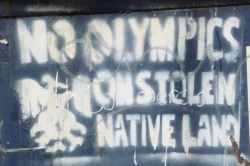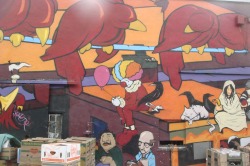tensions on the drive: a microcosm

garbage bin near commercial
Looking at the variety of street art found along the Drive highlights some tensions present in the community, and also extends to the rest of the city. The City of Vancouver has a Graffiti by-law that defines painting on someone else's property without permission as vandalism, with a minimum fine for anyone caught writing graffiti set at CDN$500. In fact, the City of Vancouver website says: "[g]raffiti can quickly transform a neighbourhood by giving a sense that there is no control in the area". By looking at the topics of some of the public art, however, it can be argued that these graffiti are sometimes used as an outlet to express their thoughts or discontent over something that they do not or cannot have influence over.
On the right is an image of phrase found on a garbage bin around the Drive: "NO OLYMPICS ON STOLEN NATIVE LAND". The author of this graffiti may be making a social commentary on several issues relevant to the community: that there were opposing voices to Vancouver being the host city of the 2010 Winter Olympics, and/or that the Grandview area does not receive enough funding for public services (and that contrasts greatly with the vast sums of money spent on hosting the Olympics), and/or that the soils of Canadian lands were historically the homeland of First Nations people (and reflects on the complexity of Native Reserves, prejudices against First Nations people, and the relative indifference of many Vancouverites and Canadians on such issues). Whatever the motivations behind this piece of graffiti, the artist is really using it as a tool to express their own inability to control the fate of this community -- then is graffiti contributing to "a sense of no control" or "taking control into their own hands"?
This tension is present all around. While there are laws and bylaws that criminalize the act of graffiti, there are other outlets that turn this notion on its head via authorized wall mural programs. These projects provide a "legal" means for artists to design their art. The subculture is continually being suppressed and negatively associated, but at the same time, there are people who are able to see the messages being represented by the subculture and its productions, and some moves to clear up misunderstandings between mainstream culture and graffiti subculture.
On the right is an image of phrase found on a garbage bin around the Drive: "NO OLYMPICS ON STOLEN NATIVE LAND". The author of this graffiti may be making a social commentary on several issues relevant to the community: that there were opposing voices to Vancouver being the host city of the 2010 Winter Olympics, and/or that the Grandview area does not receive enough funding for public services (and that contrasts greatly with the vast sums of money spent on hosting the Olympics), and/or that the soils of Canadian lands were historically the homeland of First Nations people (and reflects on the complexity of Native Reserves, prejudices against First Nations people, and the relative indifference of many Vancouverites and Canadians on such issues). Whatever the motivations behind this piece of graffiti, the artist is really using it as a tool to express their own inability to control the fate of this community -- then is graffiti contributing to "a sense of no control" or "taking control into their own hands"?
This tension is present all around. While there are laws and bylaws that criminalize the act of graffiti, there are other outlets that turn this notion on its head via authorized wall mural programs. These projects provide a "legal" means for artists to design their art. The subculture is continually being suppressed and negatively associated, but at the same time, there are people who are able to see the messages being represented by the subculture and its productions, and some moves to clear up misunderstandings between mainstream culture and graffiti subculture.
putting the project in perspective

commercial & graveley 2010
The process I went through putting together graffiti on the drive surprisingly echoes certain elements of new forms of authorship suggested in Hartling's article: genealistic, collaborative, and marginalized.
Genealistic: the interactive capacities of website applications that allow geo-tagging on online maps, such as the one I used (CommunityWalks) enhance the new literary qualities as suggested by Hartling. There is no set reading sequence in the map I have created, the tagged locations can be filtered by the colour-specific categories that I have set up, such that users can choose what to read and how to read it.
Collaborative: CommunityWalks has commenting tools and an option for other users to sign in and add/edit/delete tagged locations (but as the moderator I still have the power to limit these options as I choose). The ongoing nature of projects like graffiti on the drive means that it is possible for other users to become co-authors by contributing to my graffiti catalog, as long as they can provide images and a location to plot them onto the map.
Marginalized: the relationship between coding and interface is highlighted with graffiti on the drive. My project is limited to the resources I have available on the Internet. Because I do not know how to write my own programming, I had to adapt this project from what I had originally had in mind. For example, most geo-tagging websites, including CommunityWalks, do not allow videos to be tagged to the locations, unless I pay a premium to subscribe to the websites that do offer it. Moreover, there are also other similar mapping websites that do not provide the capacities I was looking - for example, I had originally already begun using Panaramio, a geo-tagging photo sharing website that can become available as a layer in Google Maps and Google Earth after it has been uploaded and accepted by moderators. The interface is polished and simple, and photos uploaded are available to other users, and viewable on the database of a widely used Internet search engine giant. However, I then realized that I could not create personal maps that I can link to -- everything is common property. I cannot set my own borders, link to a specific place, or tag multiple locations on my own, so I had to look for something else.
Genealistic: the interactive capacities of website applications that allow geo-tagging on online maps, such as the one I used (CommunityWalks) enhance the new literary qualities as suggested by Hartling. There is no set reading sequence in the map I have created, the tagged locations can be filtered by the colour-specific categories that I have set up, such that users can choose what to read and how to read it.
Collaborative: CommunityWalks has commenting tools and an option for other users to sign in and add/edit/delete tagged locations (but as the moderator I still have the power to limit these options as I choose). The ongoing nature of projects like graffiti on the drive means that it is possible for other users to become co-authors by contributing to my graffiti catalog, as long as they can provide images and a location to plot them onto the map.
Marginalized: the relationship between coding and interface is highlighted with graffiti on the drive. My project is limited to the resources I have available on the Internet. Because I do not know how to write my own programming, I had to adapt this project from what I had originally had in mind. For example, most geo-tagging websites, including CommunityWalks, do not allow videos to be tagged to the locations, unless I pay a premium to subscribe to the websites that do offer it. Moreover, there are also other similar mapping websites that do not provide the capacities I was looking - for example, I had originally already begun using Panaramio, a geo-tagging photo sharing website that can become available as a layer in Google Maps and Google Earth after it has been uploaded and accepted by moderators. The interface is polished and simple, and photos uploaded are available to other users, and viewable on the database of a widely used Internet search engine giant. However, I then realized that I could not create personal maps that I can link to -- everything is common property. I cannot set my own borders, link to a specific place, or tag multiple locations on my own, so I had to look for something else.
concluding thoughts
I am quite pleased with the outcome graffiti on the drive. As an attempt to connect the physical and digital worlds, I was able to use a website that met my expectations. I think that this project is another example of graffiti as a (web)subculture -- work done by graffiti writers in the physical world normally only reaches people who physically walk by that piece of artwork, or at odd times captured in photos or videos. Something like graffiti on the drive gives the option for other users connected to the Internet to see some displays of graffiti in the Drive without actually walking down the street. Samples of graffiti found along the Drive even goes as far as to highlight whatever these images may be representing, be it political, cultural, social or artsy in nature. It is a selected snapshot of the Drive through the perspective of Graffiti writers.
